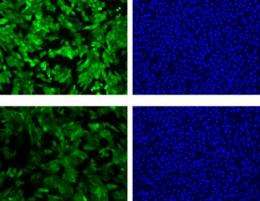NIST researchers 'all aglow' over new test of toxin strength

A new National Institute of Standards and Technology (NIST) assay using a âglow or no glowâ technique may soon help the U.S. Department of Homeland Security (DHS) defend the nation against a spectrum of biological weapons that could be used in a terrorist attack. One very dangerous toxin on the list is ricin, a protein derived from castor beans that is lethal in doses as small as 500 microgramsâabout the size of a grain of salt.
As part of its efforts to address the threat, DHS is working with NIST to create a standardized ricin sample with a known potency. Such a standard is needed both to check the accuracy of detection equipment, and, should an attack occur, to confirm the success of decontamination procedures. A major step toward this goalâthe development of a rapid, reliable and precise assay of the potency of a ricin sampleâhas now been achieved by NIST scientists.
As detailed in an article posted online this week in Assay and Drug Development Technologies, the new NIST assay uses a commercially available cell line genetically engineered to produce large amounts of green fluorescent protein (GFP). Ricin shuts down ribosomesâthe protein manufacturing factories of a cell. Assay cells exposed to the toxin will quickly stop synthesizing GFP. This, in turn, will result in a measurable decrease in fluorescenceâa drop that correlates directly to the strength of the ricin present.
The NIST assay yields many advantages over traditional cytotoxicity measuring systems, including: a highly sensitive response to ricin (as little as 1 nanogram per milliliter) within six rather than 24 hours; detection of the toxin long before significant cell death has occurred; results that are highly reproducible; no need for the addition of any reagents; and the flexibility to measure the potency of other ribosome inhibitors, even nanoparticles, with the same precision as ricin.
Citation: M. Halter, J.L. Almeida, A. Tona, K.D. Cole, A.L. Plant and J.T. Elliott. A mechanistically relevant cytotoxicity assay based on the detection of cellular green fluorescent protein. Assay and Drug Development Technologies, Vol. 7, No. 4 (August 2009; posted online the week of June 15, 2009).
Source: National Institute of Standards and Technology (NIST)















